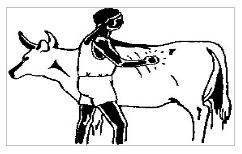Rumen movement in ruminants
Rumen movement in ruminants
Animals are divided into the following three groups :
- Carnivores which eat meat. eg. dog, lion
- Omnivores which eat meet end plants. eg. pig
- Herbivores which eat plants. eg. Cow, horse
In herbivores, the digestive system is very large because they eat large amounts of grass.
- The horse, donkey and mule are herbivores but do not chew the cud. They are non-ruminants.
- Cattle, goats, sheep and buffalo chew the cud. They are ruminants.
The rumen (Stomach)
- The stomach of a ruminant has four chambers.
- The first chamber is very large and is called the rumen.
- The second chamber is the reticulum (honeycomb).
- The third is the omasum (book).
- The fourth is the abomasum (the true stomach).
- The ruminant chews grass and swallows and it goes into the rumen.
- When the ruminant has finished eating, the food is brought back up and rechewed. This is called chewing the cud or rumination.
- If the animal stops ruminating this is a sign of ill health.
- Ruminants make a lot of gas in their stomachs and belch once every minute, (unlike people they belch silently).
- If the belching stops the stomach swells with gas. We call this bloat or tympany.
Rumen movement
The rumen moves regularly and contracts about once every minute. By putting your fist on the left flank (in the hollow behind the ribs) you will be able to detect the contractions. Regular contractions are a sign of good health.

Rumen movement
Nails and wires in the rumen
- Because ruminants eat quickly they can swallow objects like nails and wires with their feed.
- These objects can damage the rumen and can pass through the wall of the rumen into the heart and kill the animal.
- Keep nails, wires and similar objects away from animal feed and pasture.
Source : Pashu sakhi Handbook
Last Modified : 7/3/2023
© C–DAC.All content appearing on the vikaspedia portal is through collaborative effort of vikaspedia and its partners.We encourage you to use and share the content in a respectful and fair manner. Please leave all source links intact and adhere to applicable copyright and intellectual property guidelines and laws.
RELATED ITEMS
